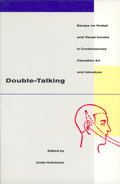Double-Talking:
Essays on Verbal and Visual Ironies in Contemporary Canadian Art and Literature
The postmodern irony “epidemic” hit Canada, as it did other nations, and it took a thoughtful form: to use Italo Calvino's words, “There is such a thing as a lightness of thoughtfulness, just as we know that there is a lightness of frivolity.” Two particular features of postmodern irony form the focus of this collection of essays: its critical function and its inherently doubled nature. These essays show that irony continues to be considered by Canadian artists and writers as a useful rhetorical and structural strategy to liberate the “blocked energies inscribed in the modernist crisis.”
Table of Contents
Introduction by Linda Hutcheon
Chapter One:
“ Who Says that Canadian Culture Is Ironic?” by Jamie Dopp
Chapter Two:
“Postmodernism in Recent Canadian Art: Ironies of Memory” by Mark A. Cheetham
Chapter Three:
“Double Exposures: The Found Poem and Ironic Reading” by Manina Jones
Chapter Four:
“The Writing on the Wall: The Ironies in and of Lothar Baumgarten's
Monument for the Native Peoples of Ontario, 1984-85” by Julie Beddoes
Chapter Five:
“The ‘Home Truth' about Home Truths : Gallant's Ironic Introduction” by Karen Smythe
Chapter Six:
“Ironic Transformations: The Feminine Gothic in Aritha van Herk's No
Fixed Address ” by Susanne Becker
Chapter Seven:
“Ironing Out the Differences: Female Iconography in the Paintings of Joanne Tod” by Karen Bernard
Chapter Eight:
“'Mother(s) of Confusion': End Bracket” by Wendy Waring
Chapter Nine:
“Ironies of Colour in the Great White North: The Discursive Strategies Of Some Hyphenated Canadians” by Arun P. Mukherjee
Chapter Ten:
“Becoming-Homosexual/Becoming-Canadian: Ironic Voice and the Politics of Location in Timothy Findley's Famous Last Words ” by Richard Dellamora
